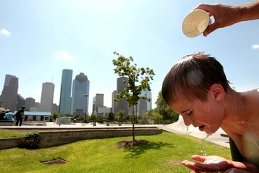 Texas – It’s been a year of superlatives for Texas: worst single-year drought, largest agricultural losses and most destructive wildfires — blazes that have damaged millions of acres and more than a thousand homes.
Texas – It’s been a year of superlatives for Texas: worst single-year drought, largest agricultural losses and most destructive wildfires — blazes that have damaged millions of acres and more than a thousand homes.
Now, as if Texans didn’t know it or hadn’t felt it the past 92 days, the state just finished the hottest June through August on record in the U.S., the National Weather Service said Thursday.
“And probably some of the most widespread water restrictions, too,” weather service meteorologist Victor Murphy said. “And they’re going to get worse.”
Texas’ 86.8-degree average beat out Oklahoma’s 85.2 degrees in 1934. That Dust Bowl year is now third on the list for the three-month span, behind No. 2 Oklahoma’s heat wave this June through August (86.5 degrees).
“This is a record we’re more than happy to let Texas have,” Gary McManus, associate state climatologist in Oklahoma, said.
Both states and others in the nation’s southern tier have baked in triple-digit heat this summer. Texas had its hottest June on record, the fifth warmest month overall, and July was the warmest month ever. Oklahoma’s July was the country’s highest monthly average temperature ever, at 89.1 degrees.
Louisiana’s heat this June through August puts it in the fourth spot all-time — 84.5 degrees.
Texas, Oklahoma, Louisiana and New Mexico each had their hottest June through August on record.
Nationwide it was the second-hottest June through August on record, averaging 74.5 degrees. Only 1936 was hotter, at 74.6 degrees. This year’s June through August average was 2.4 degrees above the long-term average (1901-2000).
The averages are reached by taking the highs and lows in entire 24-hour cycles of day, not just from daily highs.
The heat has been deadly. Seventeen people have died in Dallas County and six in Tarrant County, home to Fort Worth. One person has died in Harris County, where Houston’s located.
Of 18 Texas cities charted by Murphy, only El Paso, Corpus Christi and Brownsville did not set new average high temperatures for June through August. Wichita Falls in North Texas near the Oklahoma border topped the list with an average temperature for the three months of 91.9 degrees. Since the Texas heat began in May, the city has had 98 days of at least 100 degrees; 52 of those were consecutive days.
The combined number of at least 100-degree days in the state’s four largest cities — Houston, San Antonio, Dallas-Fort Worth and Austin — is 246. That tally is likely to climb as forecasts call for more triple-digit heat next week across much of the state.
On several occasions, the state’s electric grid implemented emergency measures that called on Texans to conserve electricity. The grid operator at times was forced to draw on additional power from Mexico’s grid and ask large industrial and commercial users to voluntarily go without power on a temporary basis. The moves helped avoid rolling blackouts.
The reason for all the hot, dry weather lies thousands of miles away in the Pacific Ocean. The La Nina phenomenon is associated with cooler sea surface temperatures in the central and eastern tropical Pacific. It brings dry conditions to the southern U.S. states.
Unfortunately, La Nina has already re-emerged, Murphy said.
“That’s the biggest concern,” he said. “That’s really worrisome right now — from a wildfire, agricultural damage and also water resource perspective.”
Texas hasn’t just been hot this summer. It’s in the midst of its worst drought since the 1950s and enduring its driest single year going back to 1895.
The heat and lack of rainfall have clobbered agriculture. An early estimate shows crop and livestock losses at $5.2 billion. That figure was expected to rise.
The drought and scorching temperatures have burned grazing pasture and rangeland, forcing ranchers to severely cull herds. Ranchers keeping animals are paying high prices for supplemental feed or the cost of transporting their animals to states with grazing land.
Producers who planted more than 2 million acres of cotton that rely on only rainfall to grow in the world’s largest contiguous growing patch around Lubbock abandoned their fields.
Texas’ economy will take a more direct hit. Agriculture accounted for $99.1 billion of the state’s $1.1 trillion economy — or 8.6 percent — in 2007, the most recent year data on food and fiber was available from the extension service. Losses in that sector have a ripple effect that’s about twice the amount of the actual agricultural loss.
Grasses, vegetation and trees around the state remain tinderbox dry and wildfires have destroyed more than 3.5 million acres since last November, about when the drought started. Just this week, hundreds of homes were destroyed when wildfires raged southeast of Austin.
Fish and other wildlife are struggling as lakes and rivers are drying up across the state and more than 850 water suppliers have implemented mandatory and voluntary restrictions on usage. Two Central Texas springs relied upon for life by eight endangered and threatened species are perilously close to levels that will require an evacuation by federal wildlife officials.
The U.S. Drought Monitor map released Thursday shows that not a speck of Texas is out of drought, and more than 81 percent is in the worst category. A year ago just 15 percent of Texas was abnormally dry, the least dry status on the map.
Other states in the southern U.S. also are in drought. Almost all of Arizona and Oklahoma are in some drought stage. All of New Mexico is mired in drought, with about 38 percent of it in the worst stage — exceptional. About 70 percent of Oklahoma is in exceptional drought.
Rain from Tropical Storm Lee improved Louisiana’s drought conditions. This week, about 17 percent of the state is in exceptional drought, down from 38 percent last week.


